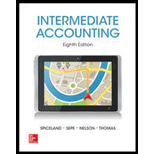
INTERMEDIATE ACCOUNTING
8th Edition
ISBN: 9780078096488
Author: SPICELAND
Publisher: MCG
expand_more
expand_more
format_list_bulleted
Concept explainers
Textbook Question
Chapter 19, Problem 19.3Q
The Tax Code differentiates between qualified option plans, including incentive plans, and nonqualified plans. What are the major differences in tax treatment between incentive plans and nonqualified plans?
Expert Solution & Answer
Want to see the full answer?
Check out a sample textbook solution
Students have asked these similar questions
Please explain the solution to this general accounting problem with accurate explanations.
I need assistance with this general accounting question using appropriate principles.
Can you solve this financial accounting problem with appropriate steps and explanations?
Chapter 19 Solutions
INTERMEDIATE ACCOUNTING
Ch. 19 - Prob. 19.1QCh. 19 - Prob. 19.2QCh. 19 - The Tax Code differentiates between qualified...Ch. 19 - Stock option (and other share-based) plans often...Ch. 19 - What is a simple capital structure? How is EPS...Ch. 19 - Prob. 19.6QCh. 19 - Blake Distributors had 100,000 common shares...Ch. 19 - Why are preferred dividends deducted from net...Ch. 19 - Prob. 19.9QCh. 19 - The treasury stock method is used to incorporate...
Ch. 19 - The potentially dilutive effect of convertible...Ch. 19 - How is the potentially dilutive effect of...Ch. 19 - Prob. 19.13QCh. 19 - If stock options and restricted stock are...Ch. 19 - Wiseman Electronics has an agreement with certain...Ch. 19 - Prob. 19.16QCh. 19 - When the income statement includes discontinued...Ch. 19 - Prob. 19.18QCh. 19 - Prob. 19.19QCh. 19 - (Based on Appendix B) LTV Corporation grants SARs...Ch. 19 - Prob. 19.1BECh. 19 - Prob. 19.2BECh. 19 - Prob. 19.3BECh. 19 - Prob. 19.4BECh. 19 - Prob. 19.5BECh. 19 - Prob. 19.6BECh. 19 - Prob. 19.7BECh. 19 - Prob. 19.8BECh. 19 - Prob. 19.9BECh. 19 - Prob. 19.10BECh. 19 - Prob. 19.11BECh. 19 - Prob. 19.12BECh. 19 - Prob. 19.13BECh. 19 - Prob. 19.14BECh. 19 - Prob. 19.15BECh. 19 - E 19–1
Restricted stock award plan
LO19–1
Allied...Ch. 19 - E 19–2
Restricted stock units
LO19–1
On January 1,...Ch. 19 - Prob. 19.3ECh. 19 - Prob. 19.4ECh. 19 - Prob. 19.5ECh. 19 - Prob. 19.6ECh. 19 - Prob. 19.7ECh. 19 - Prob. 19.8ECh. 19 - Prob. 19.9ECh. 19 - Prob. 19.10ECh. 19 - Prob. 19.11ECh. 19 - Prob. 19.12ECh. 19 - Prob. 19.13ECh. 19 - Prob. 19.14ECh. 19 - Prob. 19.15ECh. 19 - Prob. 19.16ECh. 19 - Prob. 19.17ECh. 19 - Prob. 19.18ECh. 19 - Prob. 19.19ECh. 19 - Prob. 19.20ECh. 19 - Prob. 19.21ECh. 19 - Prob. 19.22ECh. 19 - Prob. 19.23ECh. 19 - EPS; concepts; terminology LO195 through LO1913...Ch. 19 - FASB codification research LO192 The FASB...Ch. 19 - Prob. 19.26ECh. 19 - Prob. 19.27ECh. 19 - Prob. 19.28ECh. 19 - Prob. 19.29ECh. 19 - Prob. 1CPACh. 19 - Prob. 2CPACh. 19 - Prob. 3CPACh. 19 - Prob. 4CPACh. 19 - Prob. 5CPACh. 19 - Prob. 6CPACh. 19 - Prob. 7CPACh. 19 - Prob. 8CPACh. 19 - Prob. 9CPACh. 19 - Prob. 1CMACh. 19 - Prob. 2CMACh. 19 - Prob. 19.1PCh. 19 - Prob. 19.2PCh. 19 - Prob. 19.3PCh. 19 - Prob. 19.4PCh. 19 - Prob. 19.5PCh. 19 - Prob. 19.6PCh. 19 - Prob. 19.7PCh. 19 - Prob. 19.8PCh. 19 - Prob. 19.9PCh. 19 - Prob. 19.10PCh. 19 - Prob. 19.11PCh. 19 - Prob. 19.12PCh. 19 - Prob. 19.13PCh. 19 - Prob. 19.14PCh. 19 - Prob. 19.15PCh. 19 - Prob. 19.16PCh. 19 - Prob. 19.17PCh. 19 - Prob. 19.18PCh. 19 - Prob. 19.19PCh. 19 - Prob. 19.1BYPCh. 19 - Prob. 19.2BYPCh. 19 - Prob. 19.3BYPCh. 19 - Prob. 19.5BYPCh. 19 - Prob. 19.6BYPCh. 19 - Prob. 19.7BYPCh. 19 - Prob. 19.8BYPCh. 19 - Prob. 19.9BYPCh. 19 - Prob. 19.10BYPCh. 19 - Prob. 19.11BYPCh. 19 - Prob. 19.12BYPCh. 19 - Communication Case 1911 Dilution LO199 I thought...Ch. 19 - Prob. 19.14BYPCh. 19 - Prob. 19.15BYPCh. 19 - Prob. 19.16BYPCh. 19 - Prob. 19.18BYPCh. 19 - Prob. 19.19BYPCh. 19 - Prob. 19.1AFKC
Additional Business Textbook Solutions
Find more solutions based on key concepts
1-1. Define marketing and outline the steps in the marketing process. (AASCB: Communication)
Marketing: An Introduction (13th Edition)
Fundamental and Enhancing Characteristics. Identify whether the following items are fundamental characteristics...
Intermediate Accounting (2nd Edition)
The Warm and Toasty Heating Oil Company used to deliver heating oil by sending trucks that printed out a ticket...
Essentials of MIS (13th Edition)
E6-14 Using accounting vocabulary
Learning Objective 1, 2
Match the accounting terms with the corresponding d...
Horngren's Accounting (12th Edition)
Determine the price elasticity of demand if, in response to an increase in price of 10 percent, quantity demand...
Microeconomics
Real options and its types. Introduction: The net present value is the variation between present cash inflows v...
Gitman: Principl Manageri Finance_15 (15th Edition) (What's New in Finance)
Knowledge Booster
Learn more about
Need a deep-dive on the concept behind this application? Look no further. Learn more about this topic, accounting and related others by exploring similar questions and additional content below.Similar questions
- Please provide the solution to this general accounting question using proper accounting principles.arrow_forwardPlease provide the correct answer to this general accounting problem using accurate calculations.arrow_forwardI need help with this financial accounting question using standard accounting techniques.arrow_forward
- I need help with this general accounting question using standard accounting techniques.arrow_forwardI am trying to find the accurate solution to this financial accounting problem with the correct explanation.arrow_forwardPlease help me solve this financial accounting question using the right financial principles.arrow_forward
arrow_back_ios
SEE MORE QUESTIONS
arrow_forward_ios
Recommended textbooks for you
 Individual Income TaxesAccountingISBN:9780357109731Author:HoffmanPublisher:CENGAGE LEARNING - CONSIGNMENT
Individual Income TaxesAccountingISBN:9780357109731Author:HoffmanPublisher:CENGAGE LEARNING - CONSIGNMENT



Individual Income Taxes
Accounting
ISBN:9780357109731
Author:Hoffman
Publisher:CENGAGE LEARNING - CONSIGNMENT



Understanding U.S. Taxes; Author: Bechtel International Center/Stanford University;https://www.youtube.com/watch?v=QFrw0y08Oto;License: Standard Youtube License